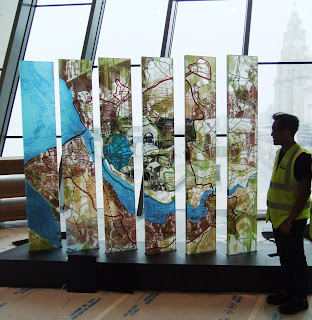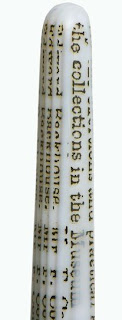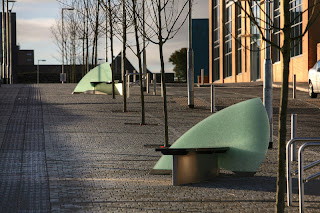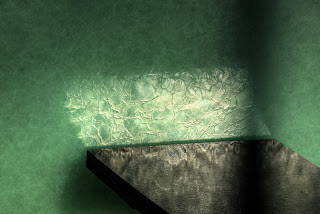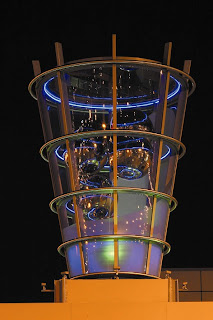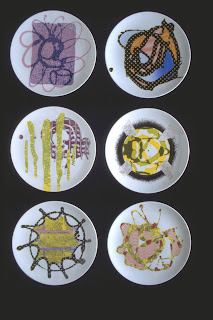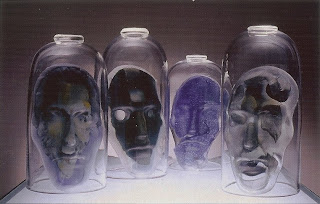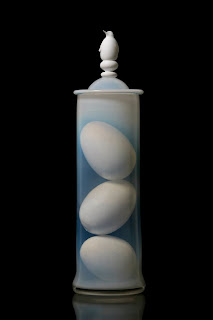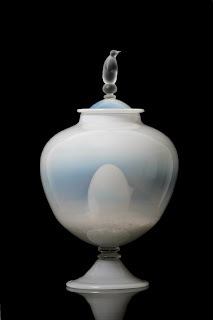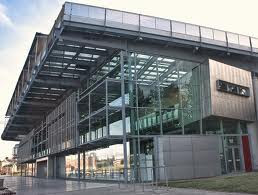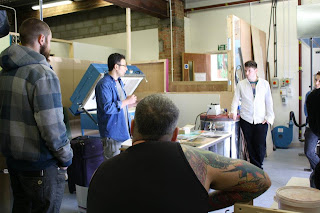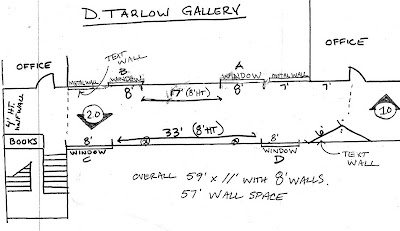>
The first big workshop, Bas-Relief dry plaster casting at the UK’s National Glass Center had gone well (phew!) The Sunderland arts organization, Creative Cohesion, was participating in the London Affordable Art Fair and had invited Tim Tate and I to exhibit our work in the contemporary art show. Which we readily agreed. Tim, my wife Kay & I jumped on a train down to London, and joined the exhibitors at the fair that had opened a couple of days earlier.
Kay Janis watches the North Sea whizz by on the train to London.
Crowd watching is part of the fun of an art fair and at London AAF it included celebrity-sightings of Johnny Depp and Joanna Lumley (Joanna looks loverly, BTW)
Tim Tate’s artwork was featured in the Creative Cohesion Booth.
L-R Dinner with the Creative Cohesion artists Kay Janis, Tim Tate, Robyn Townsend, Joanne Mitchell, Roger Tye, Anne Tye
Tim Tate tuckered out on return train trip.
Our time in London was too short, soon we were back on the train to Sunderland, and preparing for my multi-day class “Imagery in Glass” that was held in the Architectural Glass Studio of the National Glass Center.
Outlining the basics for getting detailed imagery into fused glass.
Showing the different glass powder tools and how an artist can manipulate imagery.
The master level class is tasked with creating a number of sample panels.
Students drew inspiration from the view over the river.
The first firing of glass powder imagery.
Reviewing fused glass samples with class.
Discussing options for creating effects within the layered imagery.
Jeffrey Sarmiento created a component layer for the class demo project – the artwork suggests creating bridges between the art communities.
Jeffrey Sarmiento was recently appointed Reader in Glass at the National Glass Center at the University of Sunderland. A Filipino-American artist, he holds an MFA in Glass from the Rhode Island School of Design. His research has led him to work widely in the US and Europe, having been awarded a Fulbright Scholarship Denmark. He was also a finalist for the Louis Comfort Tiffany Award and the Bombay Sapphire Prize. His most recent project is a 600kg glass map, permanently housed in the new Museum of Liverpool.
Liverpool Map Jeffrey Sarmiento and Inge Panneels, 2010
Bombay Encyclopedia
Jeffery Sarmiento talks about his work “Ossify”
Ossify 2010 British Glass Biennale Award Runner up

Emotional Leak Jeffrey Sarmiento & Erin Dickson, 2011
Cate Watkinson trained in 3-D Design, Glass with Ceramics at Sunderland Polytechnic.After leaving college Cate worked in Cambridge and the Channel Islands before returning to the North East to set up her architectural glass studio. Cate continues to run her business, Watkinson Glass Associates, while teaching at the University of Sunderland.
Over the years Cate has built on her experience, optimizing developments in new technologies, including new developments and techniques in construction. She has successfully completed a varied range of commissioned projects from glass public seating in city centers to a 22’ high sculpture for a shopping mall. From a stained glass window for Newcastle Cathedral to a laminated glass screen for the Arrivals Hall at Newcastle International Airport in the UK.
Other research activities include exploring the use of text and light through the public art commission entitled `Total Policing’, a glass and stainless steel sculpture situated at the front of the new head quarters for Northumbria Police in North Tyneside.
Total Policing
Baltic Business Quarter Public art/seating made with recycled glass.
Lookout
Next Up – Creative Cohesion artist development talk, dinner with the Uni Board, and more great UK artists!
Fulbright Scholars at University of Sunderland
>
Our Fulbright schedule began to fill the days.The first workshop we held at the University of Sunderland’s National Glass Center: “Affecting Sheet Glass – Bas-Relief Imagery in Glass” was filled. The technique of “dry plaster casing” was outlined, and firing schedules were converted from Fahrenheit to Celsius – along with converting all dimensions from imperial to metric. (Why did the US decide to not join the world in the 70’s when we were supposed to go all metricationed?)
Tim Betterton sets up the kilns for dry plaster casting.
After the firing, its like Christmas day as the students eagerly retrieve their kilnformed glass sculptures.
We were able to meet a number of incredibly talented artists that were associated with the University and their work was so strong that we will post some of the work and profiles about the artists in each of the next few blog updates:
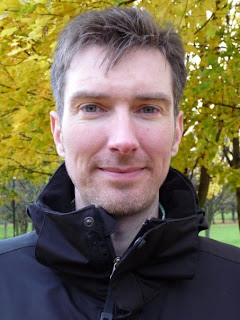
Dr Kevin Petrie leads the Glass and Ceramics department at the University of Sunderland. Kevin studied Illustration at the University of Westminster and Ceramics and Glass at the Royal College of Art. He holds a PhD in ceramics and print from University of the West of England, Bristol. Kevin’s first book ‘Glass and Print’ established the crossovers between Glassmaking and Printmaking. The book forms the cornerstone of a period of research that established the cross over between two largely separate strands of creative activity. His second book, ‘Ceramic Transfer Printing’ draws together the great potential of print for ceramics. Kevin has written many articles and reviews for journals such as Ceramic Review and presented his work on glass, ceramics and print in Canada, Thailand, Hong Kong, Denmark, Germany, USA, Australia, and China. He was recently awarded a National Teaching Fellowship for his contribution to glass and ceramics teaching, in particular this relates to postgraduate at MA, MPhil and Ph.D levels.
Dr Petrie’s work often refers to the long tradition of graphic ceramic surface decoration at the same time as reflecting contemporary life.
St Pauls Church, kilnformed glass
Cell of Himself, Kiln form glass with printed inclusions, blown glass
Besides his own work as an artist, Dr Petrie is an author, lecturer, exhibition curator, and he is an authority and specialist on contemporary glass and ceramics matters. He has lectured at the following institutions: The University of the West of England, Bristol, The University of Westminster, London, Norwich School of Art and Design, Bath Central St. Martins School of Art and Design, London, Rajabhat Institute Changmai, Thailand, Australia National University, Canberra, Australia, Monash University, Melbourne, Australia, Sydney College of the Arts, Australia, Anla Glas, Denmark, Hong Kong Baptist University – Academy of Visual Arts.
__________________________________________________________

If you are familiar with the first of the DC / Sunderland glass exhibition “Glass3” that was held in Georgetown in 2008, you might have seen James Maskrey‘s work. His work has really transformed into haunting and ethereal work. Social situations, overheard conversations, observed interactions and personal experiences hugely inspire Jim’s work. Tall stories, elaborate hoaxes and peculiar facts, usually from a bygone era, are then translated into glass, often resulting in flamboyant narratives, theatrical compositions or simple objects with a twist. The series below are from a series based on the polar expeditions by Edward Wilson to collect penguin eggs.
The Worst Journey in the World, blown and hot sculptured glass details, 2011. Photo by David Williams
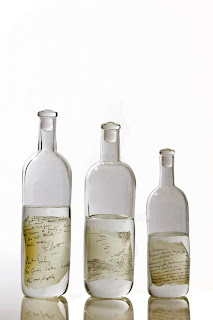

Last Entry,Winter Journey, andThe Barrier, 2011, Blown and solid formed hot glass with printed glass inclusions.
The works poetically and poignantly touches on themes of collecting and hubris. In the austral winter of 1911, Wilson led “The Winter Journey”, a doomed journey to the Emperor penguin’s breeding grounds at Cape Crozier to collect eggs for scientific study. The eggs were supposed to reveal the evolutionary links between dinosaurs and birds but their collection nearly killed the journey’s participants. Frozen and exhausted, they successfully collected three eggs and desperately exhausted they returned to Cape Evans, later describing this expedition “The Worst Journey in the World.”
James started working with glass in 1990. After graduating in 2000 with a Three Dimensional Design BA (Hons) degree in glass at The Surrey Institute of Art and Design he was appointed as Artist in Residence at the Surrey Institute. In 2001 James joined the Glass and Ceramics department at The University of Sunderland and graduated with an MA in Glass with distinction in 2004. Jim was recently named as one of the artists that will exhibit at the British Glass Biennale 2012.
Coming Next – London Affordable Art Fair & Imagery in Glass Class and featured Sunderland Artists: Jeff Sarmiento, Cate Watkinson and more!
Washington, DC Fulbright Scholars Connect with Ancestral Home of President George Washington
>As our time in the UK continued, Fellow Fulbright Scholar Tim Tate and I were invited to speak with students from St. Anthony’s – a technical specialist college in Sunderland.
Tim Tate & Michael Janis talk about the future of the arts to students at St Anthony’s in Sunderland, England.
After meeting with the students, Sunderland City Council’s Catherine Auld then took the DC crew on a quick jaunt to a couple of scenic spots that are around the city of Sunderland. First stop, the Town Hall and Indoor Market of Durham.
Tim Tate and Kay Janis at the Durham Town Hall.
Durham Town Hall and Market place were on the site since the Middle Ages. The current building dates from 1800’s.
Kay Janis seeks out notions from the indoor markets.
Nearby is the famed Durham Cathedral. The magnificent Romanesque structure dates from the 10th century, and boasts fine stained glass panels.
Durham Cathedral (and denim jeans artwork installation).
Catherine Auld, Kay Janis and Tim Tate at the Cathedral’s famed “Sanctuary Knocker”.

“Daily Bread” stained glass in Durham Cathedral by Mark Angus, 1984.
More importantly, the Cathedral, cloisters and grounds were used as some of the sets in the Harry Potter movie series.
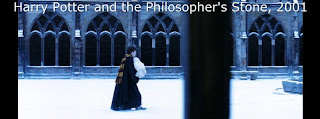
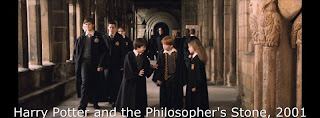
Professor Tate as Harry Potter and the Fulbright Scholar, 2012
The Saxon Origin of the Washington Family Name: This was, in fact, where the purely Saxon name of Washington derived. Among the first to bear it were the descendants of William de Hartburn near Stockton [-on-Tees], who came to live in the manor now known as Washington Old Hall as long before as 1183.
At that time, people in England and elsewhere had no surnames as we know them today, and were most often identified by the locations in which they lived. “Washington” was one of them. The name originally meant “the estate of the Hwaes family.’ “Hwaes” in its turn was the name of a Saxon chief, while “ynga” meant “family” and “ton” – a typically Saxon suffix – stood for “estate.” These three terms were linked and given a tinge of French since, like many prominent families in England, the new Washingtons sought to identify themselves with the French Plantagenet kings who succeeded the Normans and ruled England after 1154. The result was the original form of Washington – “de Wessyngton”.
Washington, DC Fulbright Scholars Tim Tate and Michael Janis pay homage to the Washington Old Hall in Durham County, UK.
Washington Old Hall was pulled down and rebuilt by the Bishop of Durham, who purchased the property from William de Wessyngton in 1613.Sadly, though, some three centuries later, it had become very dilapidated. The Hall was condemned as unfit for human habitation, and destined for demolition. It was fortunately saved from demolition by a committee specially formed to preserve it, and after thoroughgoing restoration work, the Hall was officially opened in 1955 by the then American ambassador, Winthrop W. Aldrich. Two years later, the Hall was taken over by the National Trust, an organization dedicated to preserving places of historical interest or natural beauty.
Garth Clark lecture on Ai Weiwei ceramics
The next morning, Garth Clark, noted art historian and critic – who the Washington Glass School has posted about his thoughts on the Death of Craft previously – gave a fascinating and provocative lecture about the work of Chinese bad-boy ceramic artist Ai Weiwei.
Click here to jump to first part of the Fulbright Journey blog posts.
